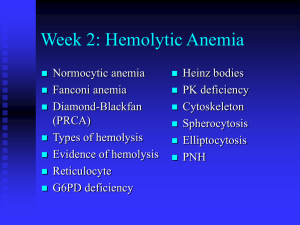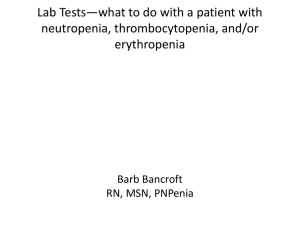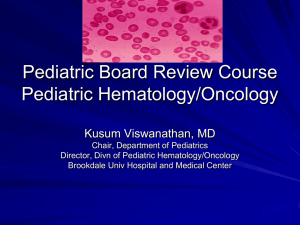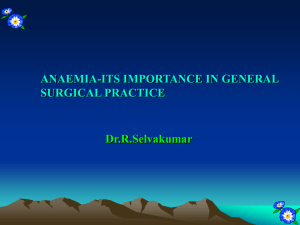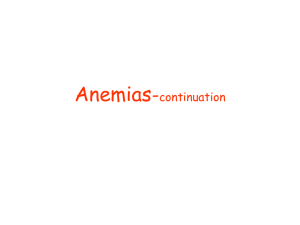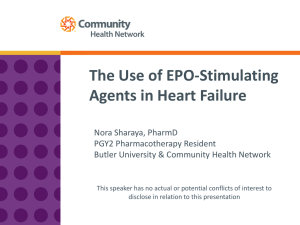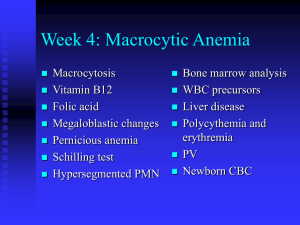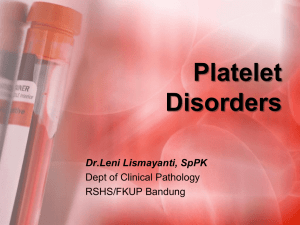nc_archive_81
advertisement
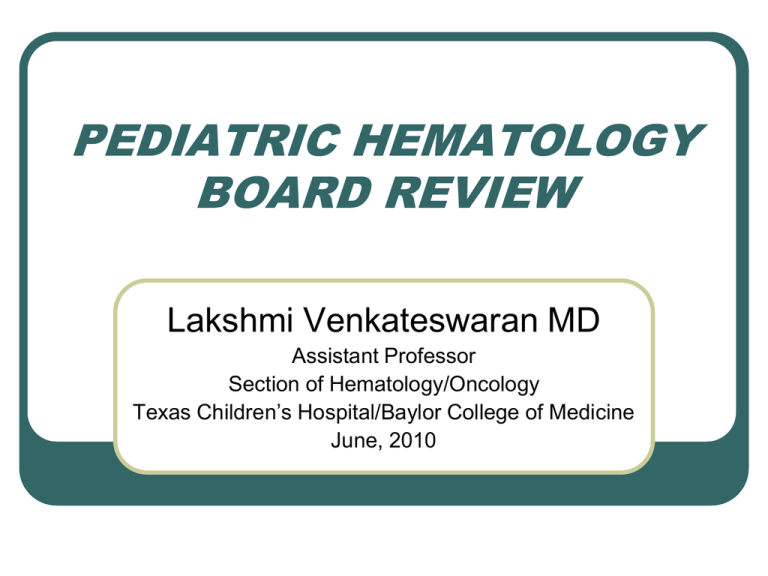
PEDIATRIC HEMATOLOGY BOARD REVIEW Lakshmi Venkateswaran MD Assistant Professor Section of Hematology/Oncology Texas Children’s Hospital/Baylor College of Medicine June, 2010 RED CELL DISORDERS NEONATAL ANEMIA Hemorrhage: • Twin-twin / feto-maternal transfusion, overt/external hemorrhage Hemolysis • Immune: ABO, Rh, minor blood group incompatibility • Infection: TORCH, sepsis, parvo virus • Red cell defects: membrane disorders, enzyme deficiencies, hemoglobinopathy, micro/macro-angiopathic hemolysis Underproduction • Fanconi’s anemia • Diamond Blackfan anemia • Schwachman-Diamond syndrome • Aase syndrome • Pearson syndrome • Dyskeratosis congenita • Congenital Dyserythropoietic anemia IRON DEFICIENCY ANEMIA Cause: • Dietary (milk based diet - esp. toddlers), blood loss (Meckel’s diverticulum, GI ulcer, polyps, hemangioma, irritation by cow’s milk protein, worm infestation), inhibition of/decreased absorption (lead poisoning, celiac disease, tropical sprue) Clinical Features: • Pica, pallor, tachycardia, heart murmur, epithelial changes; chronic – impaired growth, cognitive dysfunction, altered attention span, behavior, performance Lab Features: • Microcytosis (low MCV), increased RDW, anisocytosis, poikilocytosis, normal / low reticulocyte count, thrombocytosis IRON DEFICIENCY ANEMIA Differential diagnosis of microcytic anemia: • • • • • Lead poisoning (coarse basophilic stippling, elevated blood lead level) Thalassemia trait (MCV disproportionately low, elevated Hb A2, presence of Bart’s Hb in NB screen) Anemia of chronic disease (low serum Fe, TIBC, nl or high ferritin) Sideroblastic anemia Congenital anemia with unstable Hb Management: • • • • Oral ferrous sulfate Identify & correct cause PRBC transfusion – only for severe anemia, with cardiac failure Parenteral Fe - only in special cases MEGALOBLASTIC ANEMIA Vitamin B12 deficiency • Dietary – vegan diet (neonate with vegan mother) • Congenital disorders of absorption & metabolism • Intrinsic factor defect – gastrectomy, pernicious anemia • Disorders of ileum • Folic acid deficiency • Dietary deficiency (goat’s milk) • Defects in absorption – small bowel disorders • Inborn errors of absorption & metabolism • Drugs – anticonvulsants, methotrexate • Increased demand – pregnancy, lactation, hemolytic anemia, prematurity, alcoholism MEGALOBLASTIC ANEMIA Clinical features: • • • • • Macrocytic anemia (high MCV) low/nl reticulocyte count neutropenia, thrombocytopenia hypersegmented neutrophil megaloblastic bone marrow Management: • • • Vitamin B12 supplementation (oral / parenteral) Folate supplementation (often oral, rarely parenteral) Identify and treat the cause HEMOGLOBINOPATHIES Sickle cell disease: • • Beta globin mutation Sickled RBCs with shortened survival Lab Features: • • • • • • Normocytic anemia Increased reticulocyte count Thrombocytosis Leukocytosis Peripheral smear: sickle cells, polychromasia, Howell-Jolly bodies Hb profile: Hb SS (>50% Hb S); NB screen: FS SICKLE CELL DISEASE SICKLE CELL DISEASE • Clinical Features & management: • Hand foot syndrome – hydration, analgesics • Vaso-occlusive crisis – hydration, analgesics • Acute chest syndrome – hydration, analgesics, oxygen, • • • • • • PRBC transfusion, antibiotics Splenic sequestration crisis – PRBC transfusion, splenectomy (for recurrent crises) Aplastic crisis – PRBC transfusion Splenic dysfunction, sepsis with encapsulated organisms – broad spectrum cephalosporins, +/- vancomycin, macrolides Stroke – prevention-TCD screening, exchange transfusion Priapism – hydration, PRBC transfusion, irrigation, surgery Education about fever/pain management, spleen palpation HEMOGLOBINOPATHIES Hemoglobin C • Homozygous – mild anemia, microcytosis; target cells Hemoglobin SC • Sickle cell disease; splenomegaly; microcytosis, target & sickle cells Hb S / thalassemia • Beta zero, beta plus, alpha thalassemia Hemoglobin E • South East Asia; microcytosis, mild to moderate anemia THALASSEMIA Beta thalassemia: quantitative beta globin defect • Thalassemia major • Severe anemia, transfusion dependent, • • • • hepatosplenomegaly, characteristic facies Microcytic, hypochromic anemia, poikilocytes, target cells Management – chronic transfusion / iron chelation, splenectomy, bone marrow transplantation Thalassemia intermedia Thalassemia minor THALASSEMIA Alpha thalassemia: quantitative alpha globin defect • One gene • Silent carrier • Two genes • Thalassemia trait (microcytosis, mild anemia, Hb Bart’s in NB screen) • Three genes • Hb H disease (moderate hemolytic anemia, Hb Bart’s in NB screen, Hb H in Hb profile) • Four genes • Hydrops fetalis THALASSEMIA HEMOLYTIC ANEMIA Intrinsic • Hereditary spherocytosis • Mild, moderate, severe • Increased MCHC, spherocytes, increased osmotic fragility, • reticulocytosis Transfusion, splenectomy • Hereditary elliptocytosis • G6PD deficiency • Seen in African American, Asian, Arabic, Mediterranean population • Mild-severe; hemolysis triggered by food/drugs (fava beans, • bactrim, naphthalene, anti-malarials), infections Prevent exposure, transfusion • Pyruvate Kinase deficiency HEMOLYTIC ANEMIA Extrinsic • Paroxysmal cold hemoglobinuria • Autoimmune hemolytic anemia • Idiopathic or secondary • Often preceded by viral infection • Acute hemolysis, severe anemia, reticulocytosis, • • • hyperbilirubinemia, hemoglobinuria Mild splenomegaly Coomb’s test positive Steroids, transfusion BONE MARROW FAILURE Congenital disorders – Macrocytic anemia • • Fanconi’s anemia - rash, skeletal (thumb), cardiac, renal anomalies; supportive care, BMT Diamond-Blackfan anemia – pure red cell aplasia, macrocytic, reticulocytopenic; prednisone, BMT Transient Erythroblastopenia of childhood • Normo/macrocytic anemia, reticulocytopenia; may follow viral infection; self-resolving Acquired aplastic anemia • • • Macrocytic anemia, pancytopenia Bleeding, infections BMT, immunosuppressive therapy POLYCYTHEMIA Primary • • Polycythemia vera Familial polycythemia Secondary • • • • • Pulmonary disease Cardiac disease Renal disorders Tumors – Wilm’s, liver, adrenal gland, cerebellum, uterus, ovary Endocrine imbalance – excess steroids, androgens, growth hormone Q&A 1. On a routine-screening complete blood count, a 1-yearold is noted to have a microcytic anemia. A follow-up hemoglobin electrophoresis demonstrates an increased concentration of hemoglobin A2. The child is most likely to have a. Iron deficiency b. β-thalassemia trait c. Sickle cell anemia d. Chronic systemic illness e. Lead poisoning Q&A 2. A 15 month old infant has been breast fed since birth. He now eats finger foods (carrot, peas etc) and some cereal. His mother is a strict vegan and plans to continue the child on a similar diet. A complete blood count documents anemia. What is the most likely cause of anemia? a. Niacin b. Folic acid c. Riboflavin d. Thiamine e. Vitamin B12 Q&A 3. A 4-year-old previously well boy develops pallor, dark urine, and jaundice. There has been no apparent exposure to a jaundiced person or to any toxins. He is taking trimethoprimsulfamethoxazole for otitis media. You consider the possibility of a hemolytic crisis caused by glucose-6phosphate dehydrogenase (G6PD) deficiency. In which of the following ethnic groups is the incidence lowest? a. African American b. Greek c. Chinese d. Middle Eastern e. Scandinavian Q&A 4. On a routine newborn screen, a 2-week-old child in your clinic is noted to have sickle cell disease. As you discuss treatment options with this family, you recommend a. Monthly injections of vitamin B12 b. Tetracycline prophylaxis c. Meningococcal vaccine at 2, 4, and 6 months of age d. Education of parents regarding abdominal palpation and temperature taking e. Infusion of immunoglobulin every 6 weeks Q&A 5. A preterm black male infant was found to be jaundiced 12 h after birth. At 36 h of age, his serum bilirubin was 18 mg/dL, hemoglobin concentration was 12.5 gm/dL, and reticulocyte count 9%. Many nucleated red cells and some spherocytes were seen in the peripheral blood smear. The differential diagnosis should include which of the following? a. Pyruvate kinase deficiency b. Hereditary spherocytosis c. Sickle cell anemia d. Rh incompatibility e. Polycythemia Q&A 6. On a routine well-child examination, a 1-year-old boy is noted to be pale. He is in the seventy-fifth percentile for weight and the twenty-fifth percentile for length. Results of physical examination are otherwise normal. His hematocrit is 24%. Of the following questions, which is most likely to be helpful in making a diagnosis? a. What is the child’s usual daily diet? b. Did the child receive phototherapy for neonatal jaundice? c. Has anyone in the family received a blood transfusion? d. Is the child on any medications? e. What is the pattern and appearance of his bowel movements? Q&A 7. Having performed a complete history and physical examination on the patient, you proceed with a diagnostic workup. Initial laboratory results are as follows: hemoglobin 8 gm/dL; hematocrit 24%; leukocyte count 11,000/Μl with 38% neutrophils, 7% bands, 55% lymphocytes; hypochromia on smear; lead level 7 μg/dL whole blood; platelet count adequate; reticulocyte count 0.5%; sickle cell preparation negative; stool guiac negative; and mean corpuscular volume (MCV) 65fl. You would most appropriately recommend a. Blood transfusion b. Oral ferrous sulfate c. Intramuscular iron dextran d. An iron-fortified cereal e. Calcium EDTA Q&A 8. A 10 y/o girl c/o increasing fatigue several days after suffering from an URI. Findings on PE include obvious pallor, scleral icterus and spleen tip palpable 3 cm below costal margin. Laboratory studies reveal Hb of 6.3 gm/dl, retic count of 10% and indirect bilirubin of 2.8 mg/dl. Rest of the blood count is wnl. Past medical history is unremarkable. She has had a normal Hb at 1 year of age and has not had any lab tests until this visit. Of the following, in addition to the CBC, the most appropriate lab test to order in this patient is A. G6PD assay B. Direct Coomb’s test C. Osmotic fragility D. Haptoglobin concentration E. Hemoglobin electrophoresis Q&A 9. A 2950-g black baby boy is born at home at term. On arrival at the hospital, he appears pale, but the physical examination is otherwise normal. Laboratory studies reveal the following: mother’s blood type A, Rh positive; baby’s blood type O, Rh positive; hematocrit 38%; reticulocyte count 5%. Which of the following is the most likely cause of the anemia? a. Fetomaternal transfusion b. ABO incompatibility c. Physiologic anemia of the newborn d. Sickle cell anemia e. Iron-deficiency anemia Q&A 10. An 8-year-old patient with sickle cell anemia 11. A 7-month-old boy with severe anemia requiring transfusions, heart failure, hepatosplenomegaly, and weakness 12. A 3-day-old newborn with anemia and pathologic hyperbilirubinemia requiring phototherapy 13. A completely asymptomatic, healthy 1-year-old whose routine CBC reveals an abnormality. Q & A – a,b Q & A – c,d WHITE CELL DISORDERS NEUTROPENIA Intrinsic defects: • • • • • • • • Reticular dysgenesis Cyclic neutropenia Severe congenital neutropenia (Kostmann disease) Myelokathexis and WHIM syndrome Schwachman-Diamond syndrome Chediak-Higashi syndrome Familial benign neutropenia Bone marrow failure syndromes (congenital 7 acquired) CYCLICAL NEUTROPENIA Sporadic or autosomal dominant Regular, periodic oscillations (every 21 days; range 14-36 days) of neutrophils (rarely other cells as well) Nadir <200cells/microL S/s: fever, oral ulcers, gingivitis, periodontitis, pharyngitis, lymph node enlargement Severe: mastoiditis, pneumonia, vaginal/rectal ulcers, peritonitis; ~10% mortality Bone marrow: Hypoplasia or arrest at myelocyte stage ELA-2 mutations Management: GCSF SEVERE CONGENITAL NEUTROPENIA Autosomal recessive inheritance Incidence 2 per million ANC < 200 cells/microL Recurrent infections (skin, stomatitis, pneumonia, peri-rectal abscess; Staph aureus, E. coli, Pseudomonas sepsis) Bone marrow exam: arrest at promyelocyte / myelocyte stage ELA-2 gene mutations May develop MDS/ AML Management: GCSF (risk for leukemia) / BMT SCHWACHMAN-DIAMOND SYNDROME Clinical features: • Neutropenia (moderate to severe), recurrent infections, exocrine pancreatic insufficiency (diarrhea), growth retardation / short stature, metaphysial chondrodysplasia / skeletal abnormalities SDS gene mutation ~90% of patients Bone marrow: • Decreased myeloid precursors Cancer predisposition syndrome, can progress to bone marrow failure Management: GCSF, BMT, pancreatic enzyme supplement CHEDIAK-HIGASHI SYNDROME Autosomal recessive inheritance Clinical features: • Partial oculo-cutaneous albinism, recurrent infections, cranial & peripheral neuropathies; hepatosplenomegaly & pancytopenia in accelerated phase Diagnosis: • Giant lysosomes in peripheral blood granulocytes & BM myeloid precursors cells CHS gene mutations Management: treat infections, ascorbic acid, BMT NEUTROPENIA Extrinsic defects: • • • • • • • • • • Infection Drugs Autoimmune neutropenia Chronic benign neutropenia of childhood Associated with immune dysfunction Associated with metabolic diseases Nutritional deficiencies Reticuloendothelial sequestration Bone marrow infiltration Chronic idiopathic neutropenia CHRONIC BENIGN NEUTROPENIA OF CHILDHOOD Most common cause Median age 8-11 months (range 3-38 months) ANC 0-500 May last for several months (median 20; range 6-54 months) Diagnosis: • • Anti-neutrophil antibody usually positive BM exam: Maturation arrest at earlier stages Management: • • • Treat infections, counsel parents Rarely GCSF Reassurance - Self-resolving NEONATAL ALLOIMMUNE NEUTROPENIA Analogous to Rh hemolytic disease May last for several weeks to 6 months Diagnosis: • • Mother - NA1 & NA2 antigen negative; antibody positive Father & patient antigen positive Self-resolving Management: • • Treat infections May consider GCSF NEUTROPHILIA Acute / Chronic infection Chronic inflammation Tumors Myeloproliferative disorders Drugs (lithium, ranitidine, corticosteroids) Leukemoid reactions Post-neutropenia rebound Chronic idioapthic neutrophilia Familial cold urticaria Splenectomy Leukocyte adhesion deficiency Stress, exercise, epinephrine Hypoxia Q&A 14. An otherwise healthy child has on his 1-year-old routine CBC the polymorphonuclear neutrophil shown in the following illustration. This child likely has a. Malignancy b. Iron deficiency c. Folic acid deficiency d. Dohle inclusion bodies e. The Pelger-Huet nuclear anomaly Q&A 15. A 12 month old infant presents with 3 day history of rhinorrhea, decreased appetite and temperature of 101.5 C. On PE, the child is happy, playful and has no other findings except rhinorrhea. Since 8 months of age, the CBC has consistently shown WBC count of 2400 to 3000 (2.4 - 3x109/L), and ANC less than 400. A bone marrow exam at 11 months showed granulocytopenia with normal trilineage precursors. Besides occasional cold, the child has not had any serious infections. Of the following, the management strategy that is most appropriate is A. Allogenic BMT B. IVIG C. Prophylactic antibiotic therapy D. GCSF E. Symptomatic supportive care EOSINOPHILIA Allergic disorders: Asthma, hay fever, urticaria, drug reaction, acute bronchopulmonary aspergillosis Dermatitis: Atopic dermatitis, pemphigus, pemphigoid Infections: Invasive parasites, PCP, Toxoplasmosis, Malaria, Scabies, Coccidioidomycosis Tumors: Brain tumors, Hodgkin / NHL, myeloproliferative disorders, eosinophilic leukemia Hereditary eosinophilia GI disorders: Regional enteritis, milk precipitin disease Hypereosinophilic syndromes Miscellaneous: Immunodeficiency disorders MONOCYTOSIS Hematologic disorders • Leukemia / lymphoma, neutropenia Collagen vascular disorder Granulomatous disease • Ulcerative colitis, regional enteritis, sarcoidosis Infection • Subacute bacterial endocarditis, Tuberculosis, syphilis, protozoal / rickettsial infections; FUO Post-splenectomy state Q&A 16. During a routine-screening CBC, a 1-year-old is noted to have eosinophilia. Which of the following most likely will cause increased eosinophilia in the peripheral blood smear? a. Bacterial infections b. URI c. Fungal infections d. Invasive parasitic infestation e. Tuberculosis CONGENITAL PLATELET DISORDERS Quantitative • Thrombocytopenia absent radius syndrome • Neonate with absent radius, platelet count improves after 1 year • Amegakaryocytic thrombocytopenia • Bone marrow failure; isolated thrombocytopenia, may progress to pancytopenia / MDS; management – BMT • Wiskott-Aldrich syndrome • X-linked recessive; triad of immunodeficiency, eczema, thrombocytopenia (small platelets) • Congenital macrothrombocytopenia (MYH 9 disorder) • May-Hegglin & others; large to giant platelets; some have Dohle bodies; may have renal, eye (cataract), hearing defects CONGENITAL PLATELET DISORDERS Qualitative • Glanzmann thrombasthenia • Normal platelet count, bleeding since infancy; Gp IIb/IIIa defect; platelet transfusion for major bleeds / rF VIIa • Bernard-Soulier syndrome • Thrombocytopenia; Gp Ib/IX defect; platelet transfusion for major bleeds / rF VIIa • Gray platelet syndrome • Absence of platelet granules • Storage pool disorder • Platelet secretion defect ACQUIRED PLATELET DISORDERS Acquired thrombocytopenia • Immune thrombocytopenic purpura • Immune mediated, may follow viral infection, • • • • • vaccination Destruction of antibody coated platelets Physical exam – normal except petechiae, bruises Lab features: Isolated thrombocytopenia, mixture of normal and large platelets Diagnosis of exclusion, BMA not necessary in typical cases Management: steroids, IVIG; platelet transfusion only for life threatening bleeding ACQUIRED PLATELET DISORDERS Acquired thrombocytopenia • Neonatal alloimmune thrombocytopenia (NAIT) • Platelet equivalent of Rh disease • Mother HPA1a negative, father & patient positive • Moderate to severe thrombocytopenia • Increased risk for intracranial bleeding • Test mother & father for platelet antigen • • incompatibility Treatment: antenatal – IVIG/prednisone; post-natal – random donor/maternal platelets, IVIG Counsel for future pregnancies ACQUIRED PLATELET DISORDERS Acquired thrombocytopenia • • • • • • • • • • • • Infections – DIC, viral, fungal infections Drugs Microangiopathic – hemolytic uremic syndrome / TTP Hypersplenism Vitamin B12, folate, Fe deficiency Polycythemia Liver disease Kassabach-Merritt syndrome Cardiac prosthesis, cardiopulmonary bypass Aplastic anemia Leukemia Hypothermia Q&A 17.Two weeks after a viral syndrome, a 2-year-old child develops bruising and generalized petechiae, more prominent over the legs. No hepatosplenomegaly or lymph node enlargement is noted. The examination is otherwise unremarkable. Laboratory testing shows the patient to have a normal hemoglobin, hematocrit, and white blood count and differential. The platelet count is 15,000/μL. The most likely diagnosis is a. von Willebrand disease b. Acute leukemia c. Idiopathic (immune) thrombocytopenic purpura d. Aplastic anemia e. Thrombotic thrombocytopenic purpura Q&A 18. Appropriate treatment of this child includes a. Intravenous gamma globulin b. Platelet transfusion c. Aspirin therapy d. Factor VIII infusion e. Prednisone, vincristine, and asparaginase induction followed by methotrexate and 6-mercaptopurine Q&A 19. A newborn infant is born with petechiae scattered across his body. His platelet count is noted to be 22,000/μL with a hemoglobin of 12 mg/dL. Which of the following is most likely to explain this infant’s condition? a. Congenital cytomegalovirus infection b. Uncomplicated prematurity c. Chlamydial conjunctivitis d. Maternal ingestion of aspirin e. Nasolacrimal duct stenosis Q&A 20. A 3-year-old child presents with a petechial rash but is otherwise well and without physical findings. Platelet count is 20,000/μL; hemoglobin and WBC count are normal. The most likely diagnosis is a. Immune thrombocytopenic purpura (ITP) b. Henoch-Schonlein purpura c. Disseminated intravascular coagulopathy (DIC) d. Acute lymphoblastic leukemia e. Systemic lupus erythematosus (SLE) Q&A 16. A male infant is born without right thumb. Lab testing reveals platelet count of 60x109/L. Of the following the best management of this patient is a. Bone marrow biopsy b. Computed tomography of head c. Genetics consultation d. Intravenous corticosteroid therapy e. Intravenous immunoglobulin therapy THROMBOCYTOSIS Inflammation Infection (commonly seen after viral infections) Acute & chronic bleeding Iron, vitamin E deficiency Hemolytic anemia Asplenia Malignancy Drugs (epinephrine, vinca alkaloids) Nephrotic syndrome Graft-versus-host disease Kawasaki disease Essential thrombocythemia - rare COAGULOPATHY Congenital disorders • Hemophilia A, B, C • Clotting factor (8,9,11) deficiency • Mild, moderate, severe • Post-circumcision bleeding, epistaxis, soft tissue • • bleed, muscle hematoma, hemarthrosis, posttraumatic / surgical bleeding, intra-cranial bleeding Lab features: PTT prolonged, low factor level Management: Factor replacement, education, physical therapy, prevention, prophylaxis COAGULOPATHY Congenital disorders • Von Willebrand disease • Deficient or defective von Willebrand antigen • Type I, II (A, B, M, N), III • Lab test: PTT may be prolonged; abnormalities of • • • von Willebrand antigen / activity / multimer; low platelet count in type 2B Type I – common; epistaxis, mucosal bleeding, menorrhagia, post-traumatic/surgical bleeding Treatment – DDAVP/Stimate, factor replacement (Humate P) Type II, III – severe, need factor replacement (Humate P) COAGULOPATHY Acquired disorders • DIC – prolonged PT, PTT, low fibrinogen, • • • • thrombocytopenia, elevated D dimer / fibrin split products Drugs – anticoagulants Antibodies to clotting factors Liver disease – prolonged PT, PTT, low fibrinogen Vitamin K deficiency • Clotting factors 2,7,9,10 • Hemorrhagic disease of newborn, malabsorption / chronic diarrhea, cystic fibrosis, drugs (anticonvulsants, antibiotics) • Lab features: prolonged PT, PTT, normal fibrinogen, platelet count • Management: vitamin K (oral/parenteral), FFP (acute bleeding) Q&A 22. A 2-year-old child in shock has multiple nonblanching purple lesions of various sizes scattered about on the trunk and extremities; petechiae are noted, and oozing from the puncture site has been observed. The child’s peripheral blood smear is presented. Clotting studies are likely to show which of the following? Q&A a. Increased levels of factor V and VIII b. A decreased prothrombin level c. An increased fibrinogen level d. The presence of fibrin split products e. Normal partial thromboplastin time (PTT) Q&A 23. A 10-year-old boy is admitted to the hospital because of bleeding. Pertinent laboratory findings include a platelet count of 50,000/μL, prothrombin time (PT) of 15 s (control 11.5 s), activated partial thromboplastin time (aPTT) of 51 s (control 36 s), thrombin time (TT) of 13.7 s (control 10.5 s), and factor VIII level of 14% (normal 38 to 178%). The most likely cause of his bleeding is a. Immune thrombocytopenic purpura (ITP) b. Vitamin K deficiency c. Disseminated intravascular coagulation (DIC) d. Hemophilia A e. Hemophilia B Q&A 24. A term infant who was delivered at home is breastfeeding poorly. She is referred to you 7 days after birth by a lactation consultant because of bleeding from the umbilical cord and blood in stool. Findings on PE are normal, there are no petechiae, purpura, hepatosplenomegaly or neurologic abnormality. Of the following, the most likely diagnosis is A. DIC B. Neonatal alloimmune thrombocytopenia C. Classic vitamin K deficiency D. von Willebrand disease E. Factor VIII deficiency THROMBOSIS Venous or arterial Cause: • • • • Central venous access device – most common Idiopathic Inherited thrombophilic conditions: protein C/S, antithrombin deficiency, factor V Leiden, prothrombin G20210A mutation, MTHFR mutation, elevated lipoprotein a Acquired conditions: Infections (MRSA), malignancy, trauma, systemic lupus erythematosus, nephrotic syndrome, protein losing enteropathy, congenital heart disease, prolonged immobilization THROMBOSIS Clinical features: • • • • Deep venous thrombosis – swelling, pain, discoloration Stroke Pulmonary embolism – cough, shortness of breath, hypoxia, cyanosis Arterial thrombosis: pain, pallor, swelling, ischemic/gangrenous changes, organ dysfunction Diagnosis • • • Gold standard – contrast angiography – rarely done Ultrasound – Doppler MRV/MRA, CT angiography, echocardiography, V/Q scan THROMBOSIS MANAGEMENT Anti-thrombotic therapy: • • Anticoagulants – unfractionated heparin, low molecular weight heparin, vitamin K antagonists (coumadin), others Thrombolytic agents – tPA Mechanical thrombectomy Surgical thrombectomy ANSWERS 1. b 2. e 3. e 4. d 5. b 6. a 7. b 8. b 9. a 10. c 11. d 12. a 13. b 14. c 15. e 16. d 17. c 18. a 19. a 20. a 21. c 22. d 22. c 24. c
